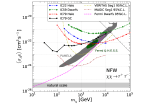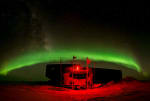In a new study presented a few days ago, the IceCube Collaboration reports the potential of atmospheric muons detected in IceCube to help our understanding of important properties of cosmic rays in a wide range of energies. These muons are also shown to be useful for investigating systematic uncertainties in neutrino studies in IceCube. Measurements of the composition of primary cosmic rays, the high-energy spectrum of muons, and the prompt flux are three of the highlights of this paper, which was submitted last Friday to Astroparticle Physics. […]
News
Week 24 at the Pole
If you blur your vision slightly, the green tablecloth might be mistaken as grass and the entire scene as one of a summertime outdoor picnic. But it’s still winter at the South Pole—midwinter to be precise, one of several milestones they traditionally celebrate with a special dinner. […]
Week 23 at the Pole
South Pole … greenhouse? That’s right. One of the coldest places on the planet hosts a very nice, warm greenhouse, replete with tomatoes and leafy greens. It’s a jungle in there. […]
Week 22 at the Pole
They’re getting fancy at the Pole—wide angles showing off curves and long exposures leaving star trails in the night sky. With its long stretch of darkness broken only by spells of auroras or the rising of a sunlike moon, winter makes the South Pole a captivating place. […]
An IceCube neutrino alert triggers the discovery of a supernova
On March 30, 2012, IceCube detected two high-energy neutrino events. IceCube immediately sent an alert to several optical and X-ray telescopes—the Robotic Optical Transient Search Experiment (ROTSE), the Palomar Transient Factory (PTF) and the Swift satellite—and a core-collapse supernova was discovered in the PTF images. However, physicists have shown that this was a coincidental discovery and that this supernova is not likely to be the source of the neutrinos in IceCube. These results have been submitted today to the Astrophysical Journal and are the outcome of a joint study between the IceCube Collaboration and members of the PTF Collaboration, the Swift Collaboration and the Pan-STARRS1 Science Consortium. […]
A search for dark matter in the galactic center
In a new analysis of the IceCube Collaboration, a search for dark matter annihilation at the Galactic Center is presented using data from May 2010 to May 2011. The highest density of dark matter in the Milky Way is anticipated to concentrate in its center. Dark-matter self-annihilation should then produce a flux of muon neutrinos and other particles that peaks in the direction of this region, which is seen in the Southern Hemisphere by IceCube. The search did not find a neutrino excess, and the researchers have set new limits on the dark-matter self-annihilation cross section. These results have been submitted today to European Physical Journal C. […]
Week 21 at the Pole
Is that the sun or the moon? That’s the moon alright—since it’s still winter at the South Pole, we know the sun has set and won’t show itself again for awhile. But with such a bright moon, you can see for quite some distance. […]
Week 20 at the Pole
The auroras have been been bright and lively lately. And even though this one curves downward, it does not bring a frown to mind. In fact, in the the full-sky panorama view it converts to a smile. […]
Spokesperson Olga Botner begins second term leading the IceCube Collaboration
Prof. Botner is now starting her second term as the spokesperson for IceCube. Her colleagues have again chosen her to lead the collaboration, and she is ready to continue what is a highly demanding but also rewarding task. […]
Week 19 at the Pole
Last week was fairly quiet as far as the IceCube detector went—no major happenings there. But the sky, on the other hand, what a scene! The auroras (australis, that is) were particularly brilliant and striking. […]









